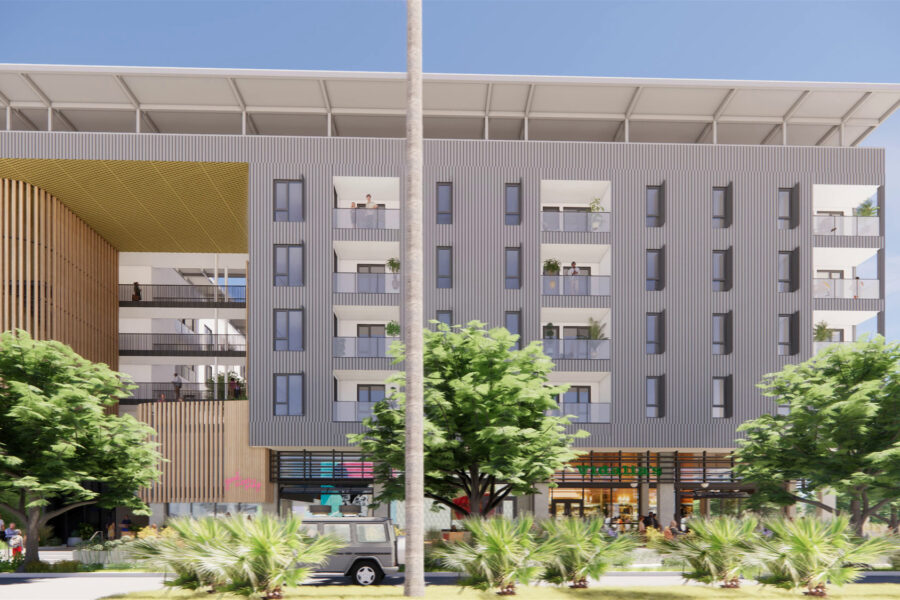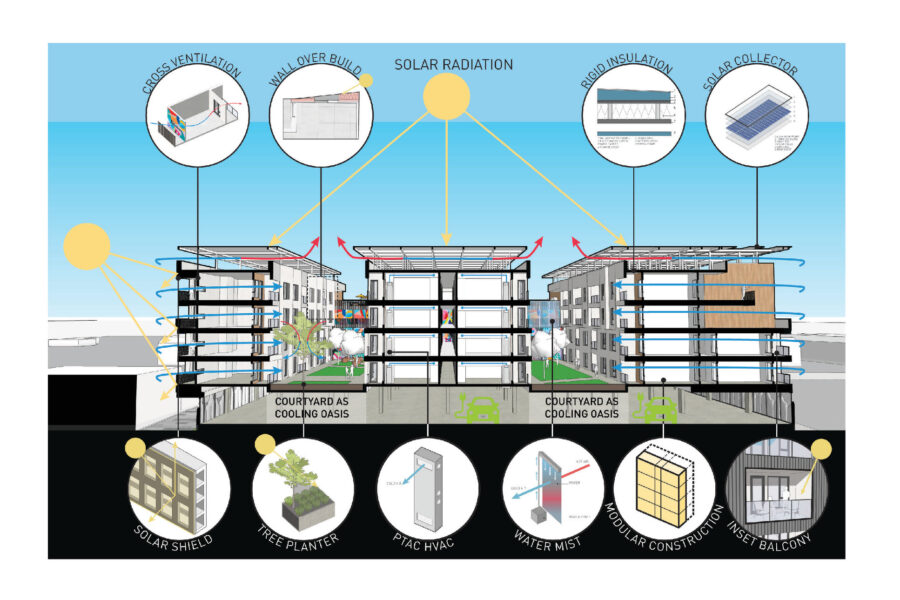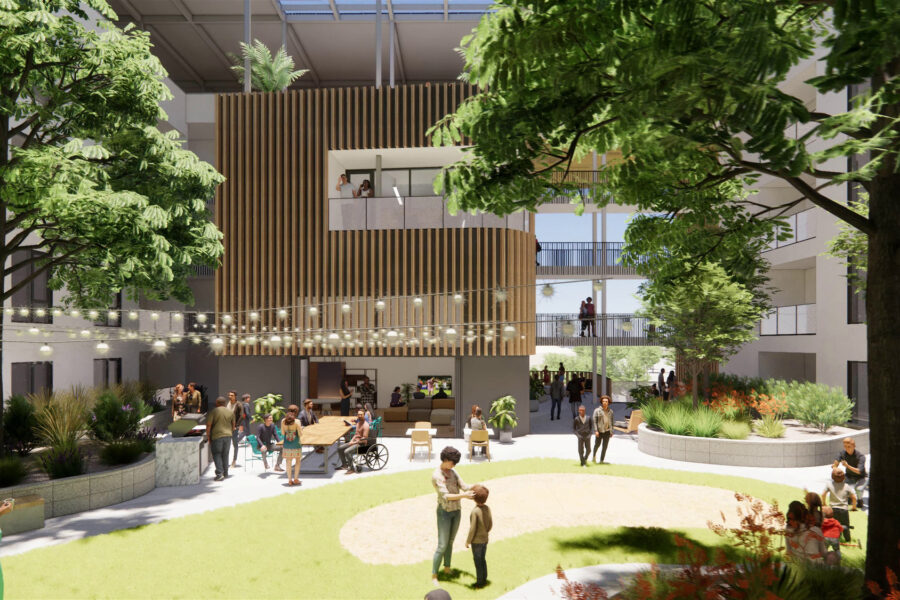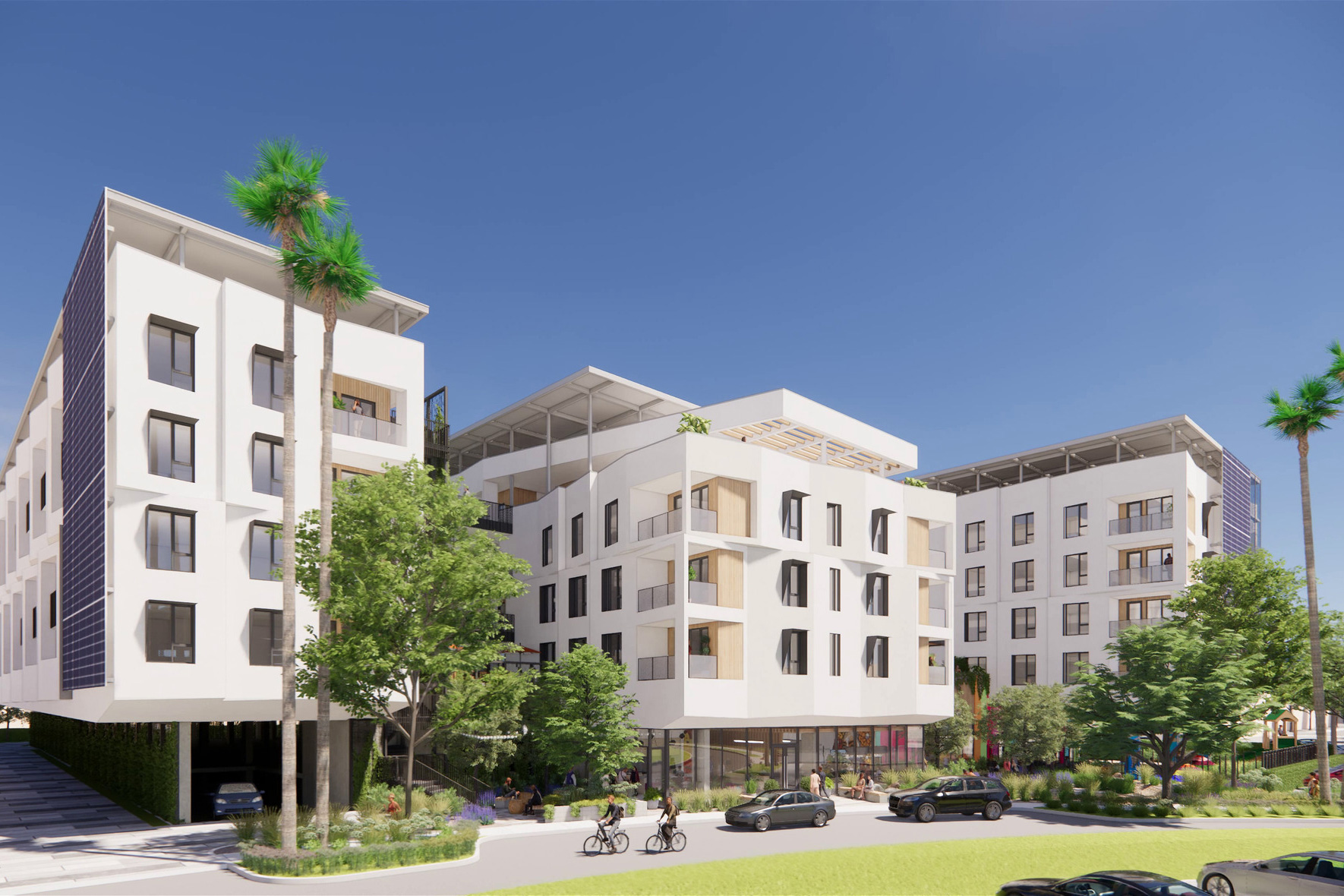Story at a glance:
- The Living Empower House aims to respond to housing needs and environmental concerns through affordable housing and climate readiness.
- The mixed use and mixed income development is designed to use modular wood construction to save time, budget, and material waste while reducing pollution.
- The development is planned to offer a blend of 20% market-rate and 80% affordable housing.
Our planet has a fever and is getting hotter every day. According to NASA, Earth warmed by two degrees during the 20th century, and it could rise another three degrees in the next several decades—resulting in unprecedented climate extremes. Future effects depend on the total amount of carbon dioxide we emit. If we can reduce emissions, we may avoid some of the worst effects.
Designed by our team at Studio One Eleven, the Living Empower House in Santa Ana California is a proposed development to create the first zero-carbon, affordable, replicable, and equitable multifamily development designed for transactive energy.
The Living Empower House responds to housing needs and environmental concerns through affordable housing and climate readiness. After securing a $1 million EPIC Grant for the research phase in 2023, the project team has been awarded a $9 million Next EPIC Grant Construction Loan with an additional $5 million matching funds from the California Energy Commission.
It is the vision of the California Energy Commission for Californians to have energy choices that are affordable, reliable, diverse, safe, and environmentally acceptable. EPIC grants were established to fund investments to advance clean energy technologies and approaches for the benefit of investor-owned utility electricity ratepayers. Starting in 2012 these grants provided an energy innovation pipeline approach to creating new energy solutions, fostering regional innovation, and bringing clean energy ideas to the marketplace.
The Project

Rendering courtesy of Studio One Eleven
This mixed use and mixed income development is designed to utilize modular wood construction to shorten the construction schedule and reduce budget, material waste, and pollution while offering overall improved quality.
Across two buildings and 230 homes, creative office, and retail space, the development will replace two underutilized office buildings with surface parking. The development stands as a beacon of inclusivity, offering a blend of 20% market-rate and 80% affordable housing, creating an environment where diverse individuals and families can thrive while positively impacting the community.
Outdoor spaces include roof terraces with mountain and coastal views, patios with firepits, and dining courts with barbecues. Other amenities include a daycare center, sports yard, ground floor retail, community rooms, dog run with pet wash, and bike kitchen.
The development is designed with three areas of focus: building efficiency, the end user, and neighborhood integration. Without looking at all three areas sustainability cannot be effectively leveraged to its maximum potential.
Building Efficiency

Image courtesy of Studio One Eleven
The Living Empower House rejects the standard “street wall,” lacking local climate responsiveness, in favor of building massing that is permeable, self-shading, open to the street, and with increased access to daylight and natural breezes. The two structures on separate sites respond to solar orientation and neighborhood context.
The north building, known as the Cross Grain Building, has lower density in response to the existing small scale residential development to the north and consists of three bars of massing, with the west facing facade a corridor that acts as a solar shield, shading the other two bars.
The south building, known as the Urban Block, is denser due to proposed adjacent projects and has several large slots to capture ocean breezes and views.
To reduce solar heat gain, horizontal canopies protect openings on south elevations while narrow windows with shade fins and large windows deeply recessed under projecting balconies are on west facades. Building materials and colors are light to further reflect heat. The project is designed with a high-performance envelope built to passive house standards.
The integration of a robust solar array by utilizing the entire roof is poised to generate 1.39 megawatt hours of electricity annually, provides thermal shading, and visually celebrates the commitment to renewable energy. The 945-kilowatt solar panel installation at the roof, west, and south facing facades reduces power by 22% and, with 2.5-megawatt hour battery storage, allows the project to operate independently from the energy grid during peak demand times.
End User
One of the most important areas of focus is providing the resident’s control of the all-electric development by controlling energy usage, transforming their roles from energy consumer to energy prosumers.
Residents will be able to control energy usage via user-friendly apps to reduce costs. For instance, occupants can turn off all non-critical energy uses like individual washer, dryer, dishwasher, non-essential plug loads, and water heaters to minimize use during peak energy demand and charges. Heating and cooling loads can be minimized by operating ceiling fans in all rooms and using operable windows carefully located to support cross ventilation. This is achieved by deep recessed balconies, providing windows on two sides of many rooms, which also reduces glare.
Owners of electric vehicles can sell their energy stored in batteries to the building at peak rates and recharge their cars when energy demand is lower and less costly. The project will also implement an electric vehicle car-sharing program, enabling tenants to access electric mobility options. This not only provides convenient transportation but also encourages the use of electric vehicles, reducing carbon emissions and promoting sustainable transportation. Residents with the lowest daily, weekly and monthly energy use will be displayed in the lobby and will be resources for neighbors interested in lowering energy consumption.
Connecting residents with nature is also important. Several existing mature Sycamore trees, upwards of 60 feet tall, have been retained to shade the building’s south facing facades. Roof terraces leveraging views to the San Gabriel Mountains and the Pacific Ocean help residents realize their unique position within the Southern California basin.
The landscape will prioritize eco-friendly construction materials, site furnishings, and efficient irrigation systems, including rainwater capture through landscape features like berms and dry creek beds with filtration devices like the modular wetlands.
Neighborhood Integration

Photo courtesy of Studio One Eleven
Not only is the development centered around creating a strong internal community; it will also support the evolution of a walkable interconnected neighborhood linked to jobs, retail, transit, health care, and schools.
Currently built as an auto-centric single use office park, the city has revised zoning for this district to support a dynamic mixed use multi-model neighborhood. The project will follow guidelines for wider sidewalks, calmer traffic speeds, and bike lanes.
The project also focuses on the ground level experience to ensure active storefronts, ample street trees to support walkability, and pedestrian scaled amenities like bike racks and lighting.
Retail at the corner of Fourth and Golden Circle and creative office space with an outdoor working terrace will animate the intersection for the Urban Block, attracting people from throughout the neighborhood. The day care center, community room, and lobby will activate the ground floor of the Cross Grain Building.
Ground floor bike storage will allow for convenient access to both downtown Santa Ana and Tustin only a few minutes away. Accessible transit stops across the street ensure connectivity to the entire region.
The city rightfully wanted to add another street to eliminate the super block structure currently in place and to support a more accessible street grid. However, the city-approved master plan recommendation to eliminate the circle altogether was something our team greatly opposed, as the round structure known as the theme building with mature palms and circular street created a unique sense of place. Ultimately we were able to convince the city to agree.
In Conclusion
Our built environment, completed over the last 80 years, has been responsible for contributing to the destruction of our planet, with automobile-based single use sprawl contributing to climate change. The Living Empower House focuses on repairing sprawl and designing energy-efficient buildings that empower residents to determine energy usage.
The project also connects to and incorporates nature with lushly landscaped outdoor space that provides shade, beauty, and mental stability to residents as well as views for a unique sense of place within our metropolis. Together these approaches serve as a model for healthy, livable, urban ecosystems.
IHO (Innovative Housing Opportunities) is the developer on this project. Consultants on this project include ARUP, Winston Engineering, Energy Coalition, ForStrategy Consulting, and Community Electricity.


